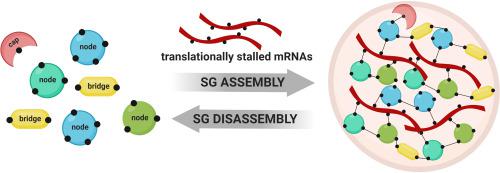Biochimica et Biophysica Acta (BBA) - Molecular Cell Research ( IF 4.6 ) Pub Date : 2020-09-29 , DOI: 10.1016/j.bbamcr.2020.118876 Sarah Hofmann 1 , Nancy Kedersha 1 , Paul Anderson 2 , Pavel Ivanov 2

|
Stress granules (SGs) are membrane-less ribonucleoprotein (RNP)-based cellular compartments that form in the cytoplasm of a cell upon exposure to various environmental stressors. SGs contain a large set of proteins, as well as mRNAs that have been stalled in translation as a result of stress-induced polysome disassembly. Despite the fact that SGs have been extensively studied for many years, their function is still not clear. They presumably help the cell to cope with the encountered stress, and facilitate the recovery process after stress removal upon which SGs disassemble. Aberrant formation of SGs and impaired SG disassembly majorly contribute to various pathological phenomena in cancer, viral infections, and neurodegeneration.
The assembly of SGs is largely driven by liquid-liquid phase separation (LLPS), however, the molecular mechanisms behind that are not fully understood. Recent studies have proposed a novel mechanism for SG formation that involves the interplay of a large interaction network of mRNAs and proteins. Here, we review this novel concept of SG assembly, and discuss the current insights into SG disassembly.
中文翻译:

应力颗粒组装和拆卸的分子机制
压力颗粒 (SG) 是基于无膜核糖核蛋白 (RNP) 的细胞区室,在暴露于各种环境压力源时会在细胞的细胞质中形成。SGs 包含大量蛋白质,以及由于压力诱导的多核糖体分解而在翻译中停滞的 mRNA。尽管 SGs 已被广泛研究多年,但它们的功能仍不清楚。它们可能有助于细胞应对遇到的压力,并促进应力消除后 SG 分解的恢复过程。SGs 的异常形成和受损的 SG 分解主要导致癌症、病毒感染和神经变性中的各种病理现象。
SGs 的组装在很大程度上是由液液相分离 (LLPS) 驱动的,然而,其背后的分子机制尚不完全清楚。最近的研究提出了一种新的 SG 形成机制,涉及 mRNA 和蛋白质的大型相互作用网络的相互作用。在这里,我们回顾了 SG 组装的这个新概念,并讨论了当前对 SG 拆卸的见解。











































 京公网安备 11010802027423号
京公网安备 11010802027423号